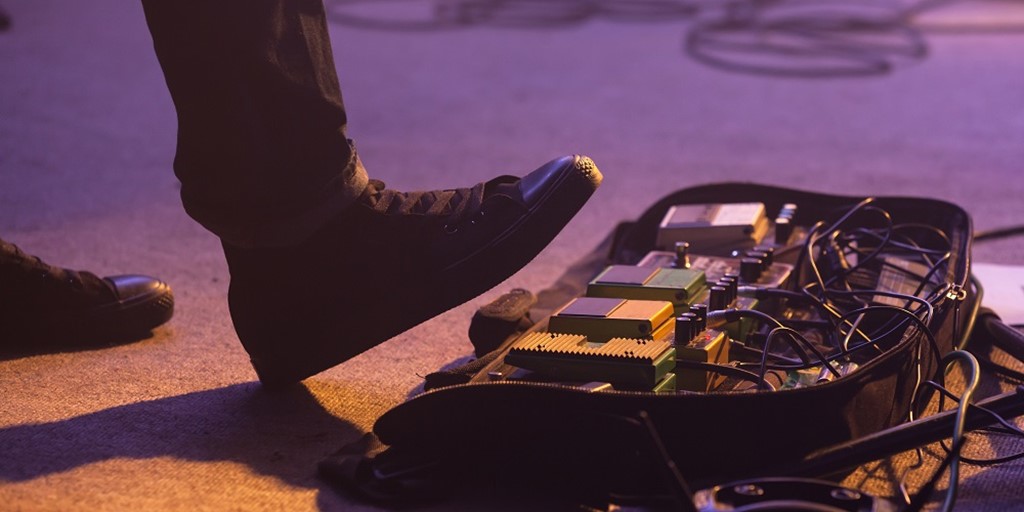

With the coronavirus outbreak forcing people to stay indoors, now is the perfect time to buy a guitar effects pedal or two if you’re a guitarist looking to create new sounds. If only learning how to use them could be simple. With the millions of pedals on the market today, that’s easier said than done. However, we’ve made the process as easy as possible with our short beginner’s guide on how to use guitar effects pedals.
Power supplies
Getting a power supply should be at the top of your list of priorities if you plan on getting serious about investing in pedals. While you may opt to use batteries for your pedals, they will inevitably run out. You’ll therefore end up spending more money through replacing them than you would if you just bought a power supply from the get-go.
The question is, how do you pick out a power supply? Let’s go through the two most basic types – the wall wart and individual power supply:
- The wall wart, as the name implies, is a power supply that you plug into the wall. All your pedals will be connected with a cable that leads back to the wall wart. The wall wart’s advantage is that it’s cheaper than the individual power supplies. However, the varying lengths of the cables could create a more muddled sound.
- The independent power supply is where all the pedals are connected independently. This suffers from the same issue as the wall wart but this can be remedied by arranging your pedals in an optimal order. Just put the pedals with the most dominant effect towards the front of the chain, while leaving the ones that are more straightforward at the end. You’d also want to make sure that your hands are dry when dealing with power supplies, as you wouldn’t want to inadvertently shock yourself.
For beginners, we’d recommend the Strymon Ojai, which you check out by playing the video above. As you’ll see, this compact power supply is perfect for small boards. Starting out, you’ll probably only have four to five pedals, so going for a bigger power supply is a little excessive. Another advantage of the Strymon Ojai as that it comes with 5-high current, fully isolated 9V outputs which will work for nearly any pedal out on the market.
Multi-effects pedals
While it may seem counter-intuitive to get a multi-effects pedal when you’re just starting out, it’s not. In fact, a good multi-effects pedal can now give you a taste of a variety of tones and sounds all in one device. And if you’re making music in your home studio, these flexible pedals are just what you need.
Since you’ll be getting a multi-effects pedal for its variety of sounds, you’ll want to get one that strikes the perfect balance between quantity and quality. Many multi-effects peals come with many pre-set effects combinations that range from your everyday distortion to phasers and flangers. As a beginner, you’ll also have to take ease of use into consideration. While the more technical pedals may allow for more tinkering, getting something too complicated might be quite intimidating when you’re just starting out.
So which multi-effects pedal should you go for? The aptly named Terraform pedal has 11 different effects in one package. The pre-set effects include an auto-wah, a chorus, a tremolo, and even the uni-vibe that is great when paired with an overdrive.
One tip for multi-effects pedals would be to add an expression pedal to pair with the multi-effects. This will add a little character to the pre-set effects, which will give you a more unique sound.
Distortion pedal
Anyone who’s ever picked up an electric guitar dreams of the day where they can just let it rip. One pedal that’ll help you do this is the reliable distortion pedal. This pedal gives you that fuzzy noisy sound that electric guitars are best known for. It takes the clean and clear tones of the electric guitar and puts them through the grinder, giving you the rambunctious sound modern rock music is built on.
So, how do you pick from the wide array of distortion pedals out there? Since this will be one of your staple pedals, you’ll want something flexible that suits your basic needs. You’ll also want something that can produce that nice fuzzy and muddy sound that distortion pedals were built for. To add to this, some distortion pedals even function well as a booster for your guitar when on low distortion settings, so looking for something like this could be your best option.
A great option is the Boss DS1, which is widely considered to be one of the best ever distortion pedals. This iconic pedal has been in use since 1978 across different rock genres such as heavy metal and punk.
A common mistake guitarists make when using distortion pedals like this is cranking everything up to the max setting. While this does have its uses, dialing back on the tone and gain knobs may help give you the perfect sound you’re looking for.
This article was written exclusively for Insure4Music by Joanna Holt.
Please note the information provided on this page should not be taken as advice and has been written as a matter of opinion. For more on insurance cover and policy wording, see our homepage.
